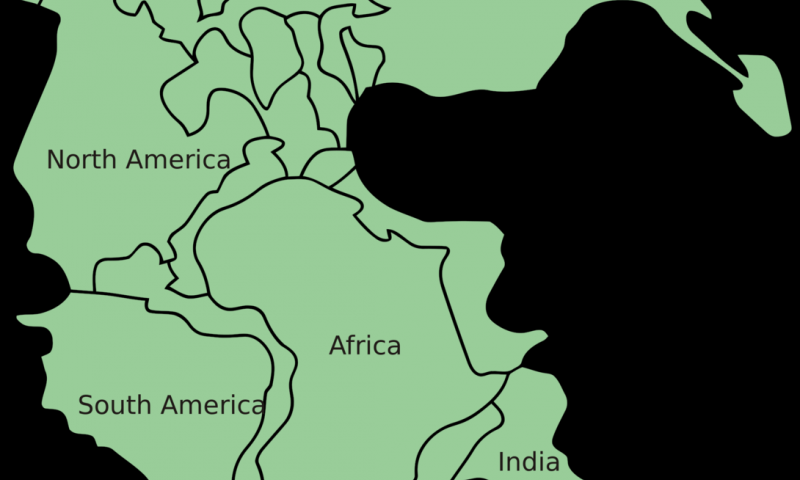At http://phys.org/print386928085.html … in 1966 J Tuzo Wilson published 'Did the Atlantic Close and Reopen?' in the journal Nature, introducing geologists to the idea continents and oceans are in constant motion across the surface of the Earth. This idea became known as Plate Tectonics – a sort of halfway house between the idea of continental drift as espoused by Alfred Wegener and the idea of rigid continents. It ws used to explain earthquakes and mountain building, a sort of all things for everyone, addressing a number of controversies in one fell swoop. It has been mainstream for the last 50 years. Alfred Wegener, incidentally, although he first advanced the idea of moving continents back in 1912 he didn't have a mechanism to explain how they might drift. He was generally dismissed by academics as they regarded him an amateur and interloper.
Wilson, a Canadian, obviously had taken onboard many of Wegener's idea and added to them, and was especially interested in the similarity between rocks in Canada and those in Europe. He thought they displayed evidence not just of moving apart from each other but also of coming together again and moving apart once more. It was this feature of drift that attracted the uniformitarians so that instead of having ocean floors that were just a couple of hundred thousand years of age they could have them appearing and disppearing for as often and over as long a period as they liked. Wegener didn't have a look in.
 It is thought the surface is divided into 15 major plates moving extremely slowly – so slowly a snail would not notice. Radiometric dating has been used to date rock on ocean bottoms and the consensus opinion is that no ocean floor is any older than 200 million years. It is not clear if ocean basalts have been firmly dated or that is an assumption based on presumptions not declared. The idea of opening and closing and reopening again and again is know as the Wilson Cycle. It is one of the base parameters of uniformitarianism – essential in fact. Without the Wilson Cycle geologists would have a problem – and so too would radiometric dating methodologies.
It is thought the surface is divided into 15 major plates moving extremely slowly – so slowly a snail would not notice. Radiometric dating has been used to date rock on ocean bottoms and the consensus opinion is that no ocean floor is any older than 200 million years. It is not clear if ocean basalts have been firmly dated or that is an assumption based on presumptions not declared. The idea of opening and closing and reopening again and again is know as the Wilson Cycle. It is one of the base parameters of uniformitarianism – essential in fact. Without the Wilson Cycle geologists would have a problem – and so too would radiometric dating methodologies.
Tied into the Wilson Cycle are a number of other consensus ideas, including the theory that earthquakes occur at plate boundaries. The San Andreas fault line is usually used as an example as it exists at what is thought to be a plate boundary, one plate subducting under the continental plate of N America (and a similar process seems to be occurring along the western coast of S America). Earthquakes also occur at fault lines which can be located virtually anywhere – but this is not addressed here. They are talking about major earthquakes such as the recent one off the coast of Japan or the Boxing Day earthquake and tsunami of a few years ago. This idea is also bound up with the so called Pacific ring of fire (volcanoes) and volcanic eruptions at plate boundaries (between the African and Asian plates for example). Basically, the idea is that continents can only break up by tectonic events – lots of them. The gradualists fail to see the catastrophic nature of this theory – but there you are. However, mainstream has another trick up its sleeve – continent break-ups are theorised to result from hot molten rock in the interior that flows. The flow pattern impacts on the lithosphere and changes the direction of the plates – and they separate if necessary.
The idea of sea floor spreading came about with the discovery of the mid Atlantic Ridge which appeared to be spewing out hot lava from the Mantle and creating new sea floor. If the Earth remains the same size, with negligible expansion, it stand to reason if new sea floor is being created old sea floor must be disappearing (swallowed up by the process of subduction at plate boundaries). One can see how important the idea of plate tectonics is to mainstream geology. Without it they are up a gum tree. On top of that we have the idea of plates rubbing against each other and on occasion slipping – causing major earthquakes (as above). Mountains are also supposed to rise up in the air as a result of one plate moving under another. In this theory it is essential that India was once a separate plate that smacked into southern Asia causing the Himalayas to rise up – even though there is little evidence of separation when fauna and flora are taken into account. As we learnt last week or the week before a new geology paper has come out to quell some problems with Plate Tectonics, namely big earthquakes that happen nowhere near plate boundaries. This link recounts the same view (taken from the study) to the effect that old plates have left an imprint on geology (areas of weakness) that the Mantle flow is able to take advantage of – which sounds a bit like making a your cake and proceeding to eat it. Old plate boundaries do not disappear is a very convenient explanation and it appears to have been invented to repel more vocal criticism of Plate Tectonics in recent years. Criticism had been muted for a long time but some geologists are biting back. However, they will never get another theory that can combine so many geological mysteries in one single hit, striking them down in one throw of the dice. However, a mystery still remains – how did plate tectonics begin?
